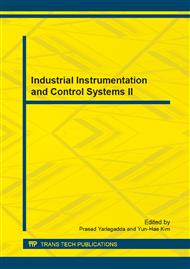p.532
p.536
p.542
p.547
p.551
p.556
p.561
p.566
p.570
The Spatial Intelligent Structural Active Control Experimental Research
Abstract:
Active control in the application has more and more research, the independent modal space control method is transform the system equation into modal coordinates, then obtain the internal decoupling equations express by modal coordinates, and based on control algorithm calculate the modal control force, which achieve real-time control effect. The control calculation method is simple and efficient to meet the needs of active control. The paper introduce modal control theory and implement methods, design and manufacture the piezoelectric driving lever based on the working principle of the piezoelectric pile, then through the test, give the voltage-driving force relationship, which is linear. An active control experiment on a three-layer intelligence space structure had been done, it can be seen that through the active control, the corresponding modal displacement and acceleration of the structures control are a lot of inhibition; at the same time, through spectral analysis, it can be seen the structured modal damping coefficient corresponding to varying degrees have been improved.
Info:
Periodical:
Pages:
551-555
Citation:
Online since:
July 2013
Authors:
Keywords:
Price:
Сopyright:
© 2013 Trans Tech Publications Ltd. All Rights Reserved
Share:
Citation:


